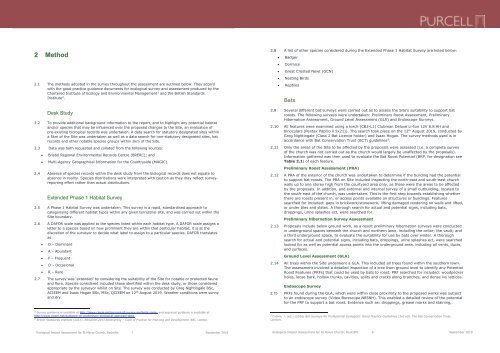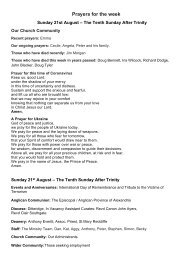St Mary Redcliffe Project 450 RIBA 2 Stage End Report
Create successful ePaper yourself
Turn your PDF publications into a flip-book with our unique Google optimized e-Paper software.
2 Method<br />
2.8 A list of other species considered during the Extended Phase 1 Habitat Survey are listed below:<br />
• Badger<br />
• Dormice<br />
• Great Crested Newt (GCN)<br />
2.1 The methods adopted in the survey throughout the assessment are outlined below. They accord<br />
with the good practice guidance documents for ecological survey and assessment produced by the<br />
Chartered Institute of Ecology and Environmental Management 1 and the British <strong>St</strong>andards<br />
Institute 2 .<br />
Desk <strong>St</strong>udy<br />
2.2 To provide additional background information to the report, and to highlight any potential habitat<br />
and/or species that may be influenced over the proposed changes to the Site, an evaluation of<br />
pre-existing biological records was undertaken. A data search for statutory designated sites within<br />
a 5km of the Site was undertaken as well as a data search for non-statutory designated sites, bat<br />
records and other notable species groups within 2km of the Site.<br />
2.3 Data was both requested and collated from the following sources:<br />
• Bristol Regional Environmental Records Centre (BRERC); and<br />
• Multi-Agency Geographical Information for the Countryside (MAGIC).<br />
2.4 Absence of species records within the desk study from the biological records does not equate to<br />
absence in reality. Species distributions were interpreted with caution as they may reflect surveyreporting<br />
effort rather than actual distributions.<br />
Extended Phase 1 Habitat Survey<br />
2.5 A Phase 1 Habitat Survey was undertaken. This survey is a rapid, standardised approach to<br />
categorising different habitat types within any given terrestrial site, and was carried out within the<br />
Site boundary.<br />
2.6 A DAFOR scale was applied to the species listed within each habitat type. A DAFOR scale assigns a<br />
letter to a species based on how prominent they are within that particular habitat, it is at the<br />
discretion of the surveyor to decide what label to assign to a particular species. DAFOR translates<br />
as:<br />
• D – Dominant<br />
• A – Abundant<br />
• F – Frequent<br />
• O – Occasional<br />
• R – Rare<br />
2.7 The survey was ‘extended’ by considering the suitability of the Site for notable or protected fauna<br />
and flora. Species considered included those identified within the desk study, or those considered<br />
appropriate by the surveyor whilst on Site. The survey was conducted by Greg Nightingale BSc,<br />
ACIEEM and Isaac Hogan BSc, MSc, QCIEEM on 12 th August 2019. Weather conditions were sunny<br />
and dry.<br />
• Nesting Birds<br />
• Reptiles<br />
Bats<br />
2.9 Several different bat surveys were carried out as to assess the Site’s suitability to support bat<br />
roosts. The following surveys were undertaken: Preliminary Roost Assessment, Preliminary<br />
Hibernation Assessment, Ground Level Assessment (GLA) and <strong>End</strong>oscope Surveys.<br />
2.10 All features were examined using a torch (CB2-L1) Clubman Deluxe Li-Ion 12V 8.8 AH and<br />
binoculars (Pentax Papilio ll 5x21)). The search took place on the 12 th August 2019, conducted by<br />
Greg Nightingale (Class 2 Bat Licence holder) and Isaac Hogan. The survey methods used is in<br />
accordance with Bat Conservation Trust (BCT) guidelines 3 .<br />
2.11 Only the areas of the Site to be affected by the proposals were assessed (i.e. a complete survey<br />
of the church was not carried out as the church would largely be unaffected by the proposals).<br />
Information gathered was then used to evaluate the Bat Roost Potential (BRP, for designation see<br />
Table 2.1) of each feature.<br />
Preliminary Roost Assessment (PRA)<br />
2.12 A PRA of the exterior of the church was undertaken to determine if the building had the potential<br />
to support bat roosts. The PRA on Site included inspecting the north-east and south-east church<br />
walls up to one storey high from the courtyard area only, as these were the areas to be affected<br />
by the proposals. In addition, and external and internal survey of a small outbuilding, located to<br />
the south-east of the church, was undertaken. This is the first step towards establishing whether<br />
there are roosts present in, or access points available on structures or buildings. Features<br />
searched for included: gaps in brickwork/stonework, lifting damaged rendering on walls and lifted,<br />
or under tiles and slates. A thorough search for actual and potential signs, including bats,<br />
droppings, urine splashes ect, were searched for.<br />
Preliminary Hibernation Survey Assessment<br />
2.13 Proposals include below ground work, as a result preliminary hibernation surveys were conducted<br />
in underground spaces beneath the church and northern lawn, including the cellar; the vault; and<br />
a third underground space, to evaluate the suitability for use by bats over winter. A thorough<br />
search for actual and potential signs, including bats, droppings, urine splashes ect, were searched<br />
looked for as well as potential access points into the underground area. including all vents, ducts,<br />
and surfaces.<br />
Ground Level Assessment (GLA)<br />
2.14 All trees within the Site underwent a GLA. This included all trees found within the southern lawn.<br />
The assessment involved a detailed inspection of a tree from ground level to identify any Potential<br />
Roost Features (PRFs) that could be used by bats to roost. PRF searched for included: woodpecker<br />
holes, loose bark, hollow trunks, cavities, splits and cracks along branches, and dense ivy lattices.<br />
<strong>End</strong>oscope Survey<br />
2.15 PRFs found during the GLA, which were within close proximity to the proposed works was subject<br />
to an endoscope survey (Video Borescope N85NH). This enabled a detailed review of the potential<br />
for the PRF to support a bat roost. Evidence such as: droppings, grease marks and staining,<br />
1 Survey guidance is available at http://www.cieem.net/sources-of-survey-methods-sosm- and appraisal guidance is available at<br />
http://www.cieem.net/guidance-on-preliminary-ecological-appraisal-gpea-<br />
3 Collins, J. (ed.) (2016) Bat Surveys for Professional Ecologists: Good Practice Guidelines (3rd ed). The Bat Conservation Trust,<br />
London.<br />
2 British <strong>St</strong>andards Institute (2013). BS42020:2013 Biodiversity – Code of Practice for Planning and Development. BSI, London.<br />
Ecological Impact Assessment for <strong>St</strong>.<strong>Mary</strong>s Church, <strong>Redcliffe</strong> 8 September 2019<br />
Ecological Impact Assessment for <strong>St</strong>.<strong>Mary</strong>s Church, <strong>Redcliffe</strong> 7 September 2019


















